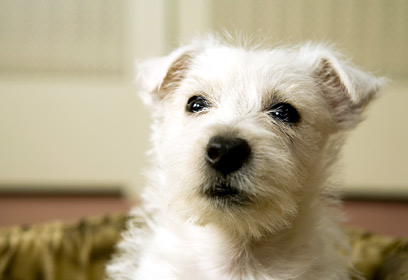
Non-verbal dialogue with dogs
The non-verbal communication skills of dogs are highly evolved. They can express social and emotional gestures through their eyes, ears, mouth and tail, and their body posture provides even more information
“He that has eyes to see and ears to hear may convince himself that no mortal can keep a secret. If his lips are silent, he chatters with his fingertips; betrayal oozes out of him at every pore.” (Sigmund Freud)
The idea of the non-verbal dialogue has captivated the minds of artists and novelists for many years. Venus’ hand gesture in the famous painting by Titian, or the innkeeper of Balzac’s “Old Father Goriot” are fine examples of non-verbal expressions.
The human verbal language is responsible for expressing patterns of thought and cognitive references. It is a structured and deliberate channel, based on facts. Our body language, on the other hand, resolves to channel and to express emotions spontaneously, with no conscious control.
This article discusses the borderline between the human and the canine non-verbal languages.

(Photo: Visual/Photos)
- For the full article – click here
In the field of psychology, through its diverse therapeutic methods, researchers would refer to the different aspects of their patients’ non-verbal demeanor as part of their personality. It was, however only in the early 20th century that these aspects were studied in research. Through the years 1915-1945 a large number of psychologists conducted experiments focusing on the correlation between facial expressions and its emotional denotation.
At that period, the subject was further studied by expert researchers in Anthropology. Although it is widely accepted today, some restrictions arise regarding the influential importance of non-verbal messages, much due to the exceeding popularity of body-language alertness. Since popular sources are quite accessible nowadays, superficial or simplistic interpretations of gestures are likely to occur.
Non-verbal communications in dogs:
The canine non-verbal manner of communication is highly evolved. It is argued that a dog communicates using its body. Its tail, eyes, ears and mouth converse with us, and the posture of the body relays further information to the message (Koren, 1994). The following patterns will exemplify:
The Tail
A dog’s tail position indicates its social status and mood. Certain parameters should be taken into account to understand the tail’s responsiveness, such as its natural pose, that differs among dogs. For instance, if the tail is not stiff, and posed near-vertically, it indicates a listening mode, as looking to see what is happening. A stiff and vertical tail would attest for the presence of a threat or invasion, as though looking to see “who’s boss around here”.

The ears say it all (Photo: Visual/Photos)
Ears
Like the tail, ears must be examined in relation to their natural state. It would be hard to interpret a message when the ears are either very short or very long. Erect ears or ears leaning forward mean attentiveness or reassessment of a new situation. Should this position be accompanied with a slight nod of the head and an open mouth, it then marks a possible interest in the occurrence, saying “I find this interesting” or “I’m not following through”. Exposure of the teeth, on the other hand is a sign of aggression in a challenging situation. Ears drawn backwards flat against the skull relay the dog is afraid or self-defending. This expresses suspicion and might indicate hesitation, aggression or both combined.
Eyes
The eyes express two main themes: Domination and Control. Looking into one’s eye is challenging, as saying “Who do you think you are?”. Such a stare relays a conflict and is more common in dominant dogs. Refraining from looking in the eye means: "I respect your authority" or "I ain't looking for trouble" - as an obedient dog would respond to a challenge.
Mouth
Dogs are incapable of as diverse communication using their mouths as humans are, but some of the expressions they make are quite significant. A limp and slightly open mouth, with the tongue peering through the canine smile, does go to say: "I'm happy". A yawn makes the least comprehensible of the dog's expressions. It is sometimes regarded as a sign of fatigue or boredom, but it is actually a sign of tension or anxiousness.
Body and paws
Dogs utilize their paws and body to relay a wide variety of feelings. In this case as well, these messages are mainly social. When a dog lies about, stretching its paws forward, back arched, hind legs standing straight and holding its head close to the ground, this suggests a classic bow, saying: "Let's play". When the dog is upright with paws standing firmly, or moving around rigidly, this asserts authority, a dominant dog ready for combat, saying "I'm boss around here, let's see what you got". If the body is slightly curved and paws are bent, this means "I accept your challenge and I'm up for the fight". If the dog rolls sideways, it means: "Let's not fight", or "I don't mean to threaten you" – this is a gesture trying to avoid confrontation. Many dogs act this way when they are relaxed. When the dog places its head or paws on another dog's shoulder, it is saying: "I’m gonna make you see who's boss around here".
Investigating non-verbal behavior and deciphering these messages rely on several factors, such as the current place and scene, participants, timing, relationship with the owner, etc.
Non-verbal expression of human emotional content
Our body language exhibits a non-verbal expression of emotional content. Emotion is by nature immeasurable and imprecise. However this does not diminish its value as a communicative and therapeutic instrument. Modern society's stress on words, together with the progression of rational methods diverts the attention from emotional life, which is exhibited as said, in one's body language.
Anyone attempting to thoroughly understand an individual's emotional life should pay attention to their body language. The regard of the non-verbal fabric leads the way to a better comprehension of better hidden and less conscious layers of personality.
Our body language is highly rich and complex. Much like the way we learn new languages, learning the body language combines theory and practice, by observing and exercising. But unlike the systematical apprehension applied by learning methods customary to modern technological society, learning our body language requires a different thinking strategy. It is not a rational method, much as emotional life is not rational.
Body language makes up a clump of visual metaphors which signal messages about a person's inner world. A tightly closed fist, for instance, is a metaphoric reference to an irritable or nervous state, tending to erupt. Open arms are a metaphor to an open and accepting emotional life.
Similar gestures in infants and dogs
Psychologists believe that infants who just started walking attain linguistic capabilities from the moment they begin responding to their own name being called, turning their head to the person who called it. The receptive linguistic ability, or otherwise, the ability to understand verbal language and non-verbal signs is the first measure for linguistic development. In addition, although a child first articulates words around the age of 12 months, psychologists argue that the baby's cries and other sounds made by it, do carry a lingual communicative content, as these sounds and gestures express feelings of pleasure or fear, thus relaying the infants’ needs.

Similar gestures between dogs and infants (Photo: Index Open)
Like infants, dogs comprehend much more than they can produce. They can normally understand information about the environment and our expectations from them.
The comparing of a baby's talk and a canine expression ends when discussing grammar or sentence structure. In human language, this means word order transformation. Around the age of two, babies begin using a two-word-sentence and comprehend the first sentence structure rules. Dogs do not seem to have any recourse to grammar. They treat a series of sounds as a single linguistic unit.
Non-speech related aspects of language
It appears that the best way to determine the existence of language in animals is to examine it in terms of infant language. We assume linguistic capability for infants who have learned only few words but can convey their will.
The initial stage of language acquisition is the receptive stage, gaining an understanding of language, not its production. The ability to produce sounds to communicate with others is a more advanced stage of language acquisition.
Milton Erickson was 17 when he was diagnosed with Polio. He became paralyzed and had to learn fundamental movements, which is actually the process infants who learn to walk undergo in their second year. Observing his year old sister, Milton learned how to move again. He tried to readjust himself to his body sensations and recreate the movements and gestures he had been capable of, prior to his disease. The direct result was a partial recovery of his ability to move. Indirectly, he developed intuition and sensitivity to movement, which according to Erickson is an expression of our very essence.
"We make these slight movements which tell everything to those who witness them. A major part of communication is conveyed through our body rather than our mouth".
He adds further:
"My insensitivity to variation of sounds forced me to pay more attention to changes of tone and rhythm. Therefore I am not very much influenced by what people are saying. Many basic characteristics reflect in the way people speak, rather than in the content of their speech".
Dr. Hanan Rotem - expressive and creative arts therapist, isotherapist, lecturer for the Haifa Academic Arab College of Education
The full article was published in Animals and Society. To contact Animals and Society: [email protected]
Translated by Asaph Talmor










